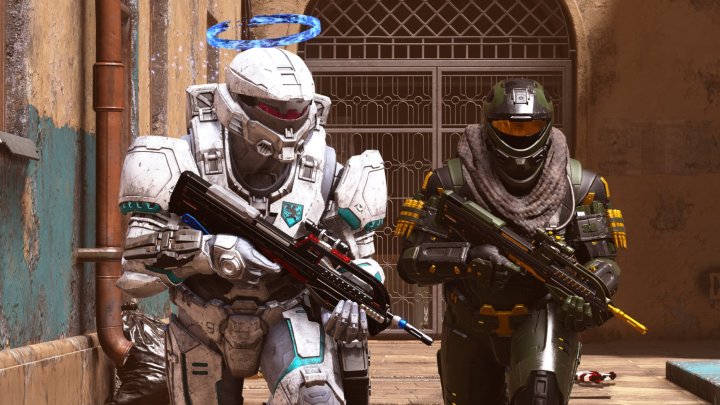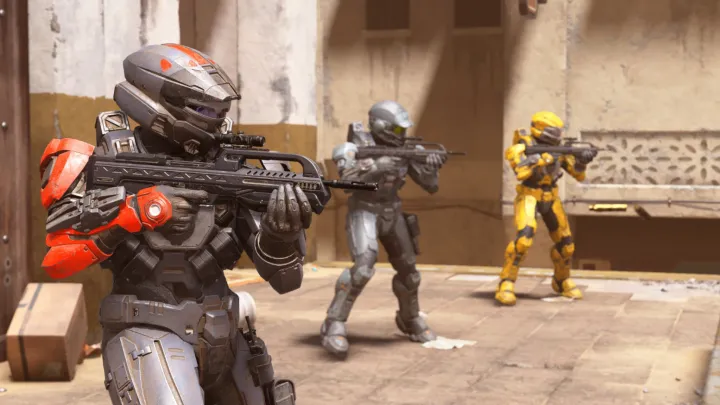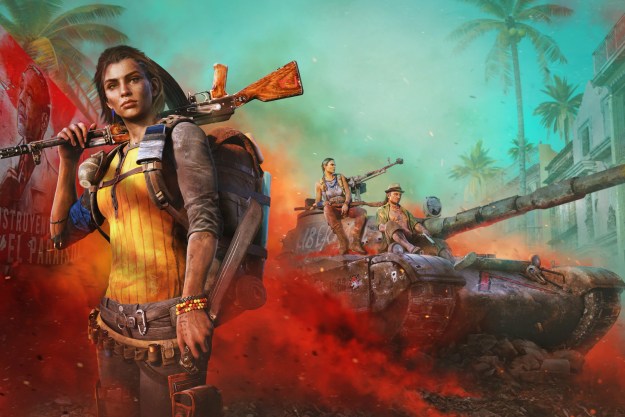Online FPS games live and die based on two main factors: Their maps and their modes. A good shooter needs both in order to keep the player’s attention and the community engaged for hours on end. Halo Infinite launched as a free-to-play multiplayer experience even before the campaign was out — a first for the series — and while celebrated for having solid gameplay, the game was lacking in the number of modes on offer. Developer 343 has been hard at work improving the game, promising more maps and modes as the seasons go on, but the ones that are there are at least the classics we all know and love from the best Halo games.
Because Halo Infinite is rather different from most modern shooters, it can include game modes that don’t typically work in games where you can kill, or be killed, in a fraction of a second. And since the series has been out of the limelight for longer than ever, a ton of brand new people are jumping into the free multiplayer to see what it’s all about. Halo Infinite expects you to know how to play when you load up multiplayer, so for the sake of your team, take a look at all the multiplayer modes and how they’re played before suiting up for battle.
See more
- Halo Infinite: Multiplayer beginner’s guide
- Is Halo Infinite cross-platform?
- Halo Infinite: All skull locations and effects
Slayer (and all variants)

Let’s start out with the classic Arena Slayer game mode. If you’re really old school, then this would technically be known as Team Slayer, but it’s been simplified for Halo Infinite. This is the most straightforward game mode in the multiplayer. It pits your team of four spartans against another with the only goal being to kill the enemy faster than they can kill you. Each kill you get earns your team one point, with the game ending either when one team reaches the maximum point total or the time running out. In the case of the latter, whichever team has the most points when the time expires wins. Arena Slayer is available in both Quick Play and Ranked Arena playlists, has a maximum score of 50, and time limit of 12 minutes.
BTB Slayer is the slight tweak on Arena Slayer you get when booting up the BTB playlist. You are still placed in a team with no objective other than to kill and not die, but now both teams have 12 members, are on larger maps, have higher kill and time limits, and typically include vehicles to spice things up. The point limit is now 100 total points, while the time limit is bumped up to 15 minutes. Obviously, this type of Slayer will only appear in the Big Team Battle playlist.
FFA Slayer is what Slayer, or Deathmatch, used to mean. This is your every man for themselves, or free for all, version of slayer. You’ve got no one to watch your back in this mode. This is much more hectic and wild than the team-focused modes, but would be a great choice for anyone who doesn’t have a team to party up with. We say would be because FFA Slayer isn’t available in any matchmaking playlists, and only found in Custom Games, which require you to invite players you know to fill up the game. When it eventually makes its way into an online playlist, we’ll update this section. For now, this mode defaults to a score limit of 25 points and time limit of 10 minutes.
Capture the Flag (and all variants)

Besides Slayer, Halo is probably best known for Capture the Flag. While by no means the only FPS to include this simple yet intense objective mode, it does fit the Halo formula quite will since the time to kill is a bit longer than most other shooters on the market, letting the matches feel more fair to people who are carrying the flag. This simple concept of bringing a flag from one place to another has a surprising amount of variants that completely change how you approach the game.
First, as always, we start with the classic Arena Capture the Flag mode. Here, two teams of four go head to head in trying to capture the other team’s flag by grabbing it, running it across the map, and bringing it to your own flag location. At the same time, the other team is also trying to do the same to your flag, forcing both teams to play offense and defense simultaneously because you cannot score the enemy team’s flag if your own flag is not still at your base. The first team to capture three flags is declared the winner, or whichever team scores the most flags within the 12 minute time limit. This game is one of the few that can also end in a tie. Arena CTF is in the Quick Play playlist, as well as playable against bots in Bot Bootcamp.
BTB Capture the Flag is exactly what it sounds like. Take Arena Capture the Flag, increase the team sizes to 12, put it on bigger maps, and increase the time limit to 15 minutes. However, there’s one key difference aside from the scale of this mode to the Arena counterpart, which is in how scoring works. Yes, you still need to grab the enemy flag and bring it back to yours, but in this mode you can still score without your flag being at home. This leads to a much more offensive-focused style of game since, if you’re quick enough, your team can score three points faster than the enemy without having to worry about protecting your own flag as much, if at all. This mode is, again, found in the Big Team Battle playlist.
The first twist on the classic CTF formula making a return in Halo Infinite is One Flag CTF. The name kind of tells most of the story for this one. There’s only one flag this time around, belonging to one of the two teams, with the mode going in rounds where each team takes turns being only on offense or only on defense. There are four rounds, each only three minutes long, or until the offensive team manages to capture the flag for a maximum of one point per round. After four rounds, the team with the most captures is the winner, or it is called a tie. One Flag CTF is only in the Quick Play matchmaking list.
Finally, we have Neutral Flag CTF, which is a twist on One Flag CTF. In both game modes there is only one flag on the map, but instead of belonging to either team, it is a neutral flag that spawns near the middle of the map. Both teams are essentially on offense here, trying to reach, claim, and return the flag to their base before the other team can. Capturing the flag will reset it, but the game is not broken into rounds like One Flag CTF, so the action is constant. Games last for 10 minutes or until either team scores the flag five times. Unfortunately, this mode is also not included in any normal playlists and can only be accessed, for now, as a Custom Game.
Oddball (and all variants)

There’s nothing more Halo than Oddball. This unique mode is an interesting blend of a bunch of different game types, but is quite simple in practice. One skull, called the Oddball, spawns on a map that can be picked up like a weapon. While holding the ball, that player can only melee attack, but gains a point for their team for every second they can hold onto it without dropping it or being killed. The rest of their team should work to protect the ball holder, while the other team fights to kill them and pick it up for themselves. This is a best-of-two round mode, with a score limit of 100, or 100 seconds, for a team to claim a round. Oddball will appear in the Arena Mode and Quick Play.
Oddball is yet another mode resigned to only Custom Games, but isn’t that appealing to us for matchmaking anyway. Just take the idea of Oddball, but remove teams. Without players to protect the ball carrier, is just becomes a slog for someone to reach the default 100 points, even in the 12 minute match time.
Strongholds
This is the only returning mode from the very divisive Halo 5. In Strongholds, there are three designated areas on the map that two teams will both attempt to capture and control in the same style as King of the Hill. After a specific point is captured, which is done by standing inside of it uncontested for a short time, that zone will begin rewarding that team one point for every second it remains under their control. You do not need to remain inside the zone once it’s captured to continue gaining points, but if the other team enters the zone, they will begin capturing it for their team. The more zones a single team controls, the more points per second they earn, but it also becomes harder to protect them all. Once one team reaches 200 points, they are the winners. Strongholds can be played in both the Arena Mode and Quick Play playlists.
Stockpile
The major complaint the community has with Halo Infinite is the lack of new modes, and we do want more, but at least we have Stockpile. This mode uses the mechanic seen in the campaign where you can pick up power seeds and insert them into receptacles. In this mode, each team has a base that they need to deposit said power seeds into to score points. These seeds are fought over, like in Neutral Flag, to be carried back, but instead of earning one point per seed, a team needs to deposit five of them to get a single point. Once either team earns three points, they are the winner. Matches can go up to 15 minutes in this mode. This mode is exclusive to the Big Team Battle playlist, meaning matches will be packed with teams of 12 on each side.
Total Control

The other new mode is another slight tweak on a mode we already talked about. Total Control is like a more hardcore Strongholds mode. The setup is almost identical, with three zones appearing on a map that teams fight to control. Where things get interesting is that controlling any one point doesn’t accomplish anything. Instead, a team only earns a point when it controls all three zones at once. When one team manages this, even for a moment, it gets the point and three new zones appear on the map. The first team to score three points wins, or the time runs out in 15 minutes. Like Stockpile, Total Control is only found in the Big Team Battle playlist for 12-on-12 action.
King of the Hill and Land Grab

Released with season 2, this is another classic game mode for the Halo franchise. King of the Hill will not be a major change from how it typically plays in Halo games. A single hill will appear on the map, which both teams fight over control over. Once a member of either team is inside the zone uncontested, their team will earn one point per second toward a total capture bar. Once one team fills that bar, they earn one total point, and the hill will move to a different location on the map.
Land Grab is something of a modification of King of the Hill. Instead of one single hill, though, there will be three that spawn at the start of the match. However, this time, when a team captures one of these points, the other team cannot reclaim it. Each captured hill awards one point, and once all three initial zones are claimed, three new ones spawn after a small delay. The first team to 11 points wins.
Last Spartan Standing

Season 2’s final addition is Last Spartan Standing, which some are claiming is akin to a battle royal mode. This mode is a free-for-all where 12 total players enter a Big Team Battle map with bespoke loadouts and only five lives. Once you run out of those five lives, the game is over for you. Getting a kill gives you the opportunity to swap out your weapon for a new one, somewhat like a gun-game mode. The game is over when only one player is left alive.
Time-limited modes
Being a live-service title now, Halo Infinite has already started rolling out new events that bring in new items and cosmetics to earn, but also a couple of much-needed modes to spice things up. These may not stick around, so make sure to play them while they’re available.
Fiesta
Fiesta is a returning mode from Halo games of the past and is just as unpredictable and chaotic as ever. This is a Slayer game at heart, but with the major change being you never know what weapons you’re going to spawn with. Each time you die and respawn, your loadout will be completely random, including Equipment. One life you might have a BR and a Rocket Launcher, the next a Plasma Pistol and Energy Sword. There are also no more weapon racks on the map, so the only way to get new guns is to find them from fallen enemies or teammates, but you obviously shouldn’t get too attached to any gun. Otherwise, the normal rules of 50 kills to win remain.
Tactical Slayer
Another returning mode coming later in season 2, Tactical Slayer is the new name for the Swat mode seen in past games. In this mode, shields are gone, as well as radar, drastically reducing the time to kill. A single headshot from a kinetic weapon will put a player down. This mode typically only has teams of four facing off, and otherwise follows normal Slayer rules. Again, we have to wait for the full mode to come out to know if and how they change it from what we know as Swat.
Editors' Recommendations
- All Trinkets in Tales of Kenzera: Zau, explained
- All Call of Duty games in order, by release date and chronologically
- The best weapons in Helldivers 2
- Best Bubble Gems in Foamstars
- All Skull and Bones beta rewards







